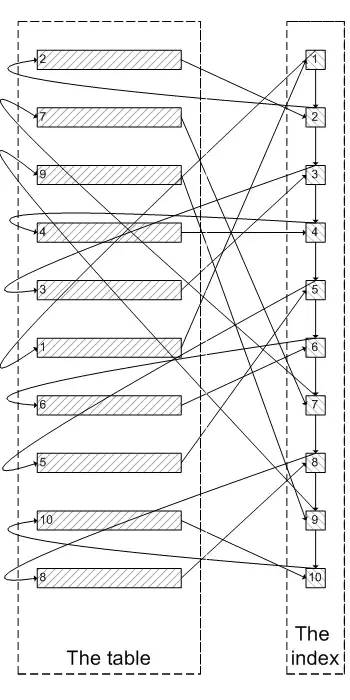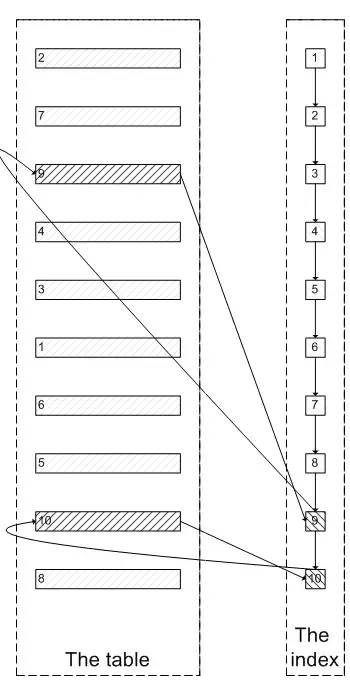是怎么样的SQL优化能做到 900W+数据,从17s到300ms?
作者丨Muscleape
jianshu.com/p/0768ebc4e28d
操作: 查询条件放到子查询中,子查询只查主键ID,然后使用子查询中确定的主键关联查询其他的属性字段; 原理:
减少回表操作; 可参考《阿里巴巴Java开发手册(泰山版)》第五章-MySQL数据库、(二)索引规约、第7条: 【推荐】利用延迟关联或者子查询优化超多分页场景。 说明:MySQL并不是挑过offeset行,而是取offset+N行,然后返回放弃前offset行,返回N行,那当offset特别大的时候,效率就非常的底下,要么控制返回的总页数,要么对超过特定阈值的页数进行SQL改写。 正例:先快速定位需要获取的id段,然后再关联: SELECT a.* FROM 表1 a,(select id from 表1 where 条件 LIMIT 100000,20) b where a.id = b.id;
-- 优化前SQL
SELECT 各种字段
FROM `table_name`
WHERE 各种条件
LIMIT 0,10;
-- 优化后SQL
SELECT 各种字段
FROM `table_name` main_tale
RIGHT JOIN
(
SELECT 子查询只查主键
FROM `table_name`
WHERE 各种条件
LIMIT 0,10;
) temp_table ON temp_table.主键 = main_table.主键
Part1前言
mysql> select version();
+-----------+
| version() |
+-----------+
| 5.7.17 |
+-----------+
1 row in set (0.00 sec)
mysql> desc test;
+--------+---------------------+------+-----+---------+----------------+
| Field | Type | Null | Key | Default | Extra |
+--------+---------------------+------+-----+---------+----------------+
| id | bigint(20) unsigned | NO | PRI | NULL | auto_increment |
| val | int(10) unsigned | NO | MUL | 0 | |
| source | int(10) unsigned | NO | | 0 | |
+--------+---------------------+------+-----+---------+----------------+
3 rows in set (0.00 sec)
mysql> select count(*) from test;
+----------+
| count(*) |
+----------+
| 5242882 |
+----------+
1 row in set (4.25 sec)
mysql> select * from test where val=4 limit 300000,5;
+---------+-----+--------+
| id | val | source |
+---------+-----+--------+
| 3327622 | 4 | 4 |
| 3327632 | 4 | 4 |
| 3327642 | 4 | 4 |
| 3327652 | 4 | 4 |
| 3327662 | 4 | 4 |
+---------+-----+--------+
5 rows in set (15.98 sec)
mysql> select * from test a inner join (select id from test where val=4 limit 300000,5) b on a.id=b.id;
+---------+-----+--------+---------+
| id | val | source | id |
+---------+-----+--------+---------+
| 3327622 | 4 | 4 | 3327622 |
| 3327632 | 4 | 4 | 3327632 |
| 3327642 | 4 | 4 | 3327642 |
| 3327652 | 4 | 4 | 3327652 |
| 3327662 | 4 | 4 | 3327662 |
+---------+-----+--------+---------+
5 rows in set (0.38 sec)


Part2证实
select * from test where val=4 limit 300000,5是扫描300005个索引节点和300005个聚簇索引上的数据节点,我们需要知道MySQL有没有办法统计在一个sql中通过索引节点查询数据节点的次数。我先试了Handler_read_*系列,很遗憾没有一个变量能满足条件。
select * from test a inner join (select id from test where val=4 limit 300000,5); 之后,buffer pool中的数据页的数量远远少于select * from test where val=4 limit 300000,5;对应的数量,因为前一个sql只访问5次数据页,而后一个sql访问300005次数据页。
select * from test where val=4 limit 300000,5
mysql> select index_name,count(*) from information_schema.INNODB_BUFFER_PAGE where INDEX_NAME in('val','primary') and TABLE_NAME like '%test%' group by index_name;Empty set (0.04 sec)
mysql> select * from test where val=4 limit 300000,5;
+---------+-----+--------+
| id | val | source |
+---------+-----+--------+|
3327622 | 4 | 4 |
| 3327632 | 4 | 4 |
| 3327642 | 4 | 4 |
| 3327652 | 4 | 4 |
| 3327662 | 4 | 4 |
+---------+-----+--------+
5 rows in set (26.19 sec)
mysql> select index_name,count(*) from information_schema.INNODB_BUFFER_PAGE where INDEX_NAME in('val','primary') and TABLE_NAME like '%test%' group by index_name;
+------------+----------+
| index_name | count(*) |
+------------+----------+
| PRIMARY | 4098 |
| val | 208 |
+------------+----------+2 rows in set (0.04 sec)
select * from test a inner join (select id from test where val=4 limit 300000,5) ;为了防止上次试验的影响,我们需要清空buffer pool,重启mysql。
mysqladmin shutdown
/usr/local/bin/mysqld_safe &
mysql> select index_name,count(*) from information_schema.INNODB_BUFFER_PAGE where INDEX_NAME in('val','primary') and TABLE_NAME like '%test%' group by index_name;
Empty set (0.03 sec)
mysql> select * from test a inner join (select id from test where val=4 limit 300000,5) b on a.id=b.id;
+---------+-----+--------+---------+
| id | val | source | id |
+---------+-----+--------+---------+
| 3327622 | 4 | 4 | 3327622 |
| 3327632 | 4 | 4 | 3327632 |
| 3327642 | 4 | 4 | 3327642 |
| 3327652 | 4 | 4 | 3327652 |
| 3327662 | 4 | 4 | 3327662 |
+---------+-----+--------+---------+
5 rows in set (0.09 sec)
mysql> select index_name,count(*) from information_schema.INNODB_BUFFER_PAGE where INDEX_NAME in('val','primary') and TABLE_NAME like '%test%' group by index_name;
+------------+----------+
| index_name | count(*) |
+------------+----------+
| PRIMARY | 5 |
| val | 390 |
+------------+----------+
2 rows in set (0.03 sec)
Part3
-End-
最近有一些小伙伴,让我帮忙找一些 面试题 资料,于是我翻遍了收藏的 5T 资料后,汇总整理出来,可以说是程序员面试必备!所有资料都整理到网盘了,欢迎下载!

面试题】即可获取
评论
